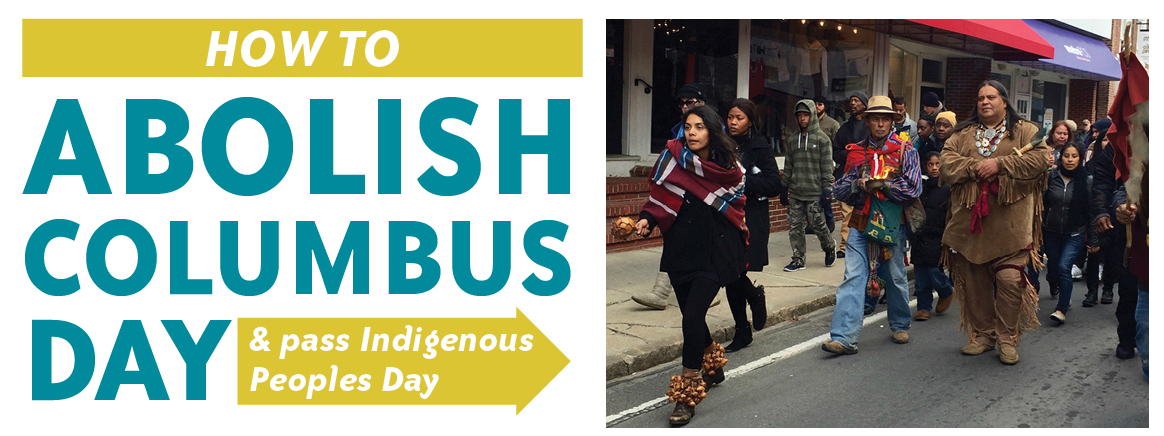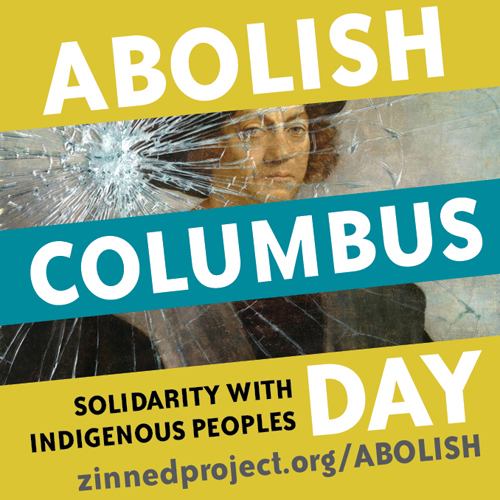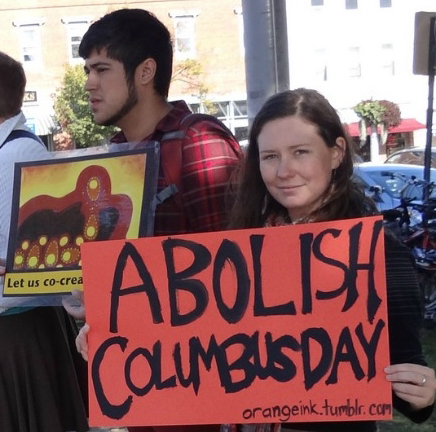As part of the campaign to Abolish Columbus Day, we present this how-to guide based on the experience of a Massachusetts Indigenous group in a city campaign that involved local community members and students. Visit our related lessons and resources page. Also read the article “Truth-Telling in American History: Groups Fight for Indigenous Peoples’ Day” that discusses some challenges other communities have overcome.
By Mahtowin Munro, United American Indians of New England
We had an amazing victory in June 2016 in the city of Cambridge, Mass., when Columbus Day was abolished and Indigenous Peoples’ Day declared. There were many Indigenous and other people working behind the scenes to garner public support for this campaign, and it took a persistent effort over several months to make sure that the City Council would do the right thing. We were fortunate also in having some strong support on the city council, and this snowballed into a unanimous vote on their part. Key elements were having a consistent campaign and message, bringing in Indigenous and non-Native people to testify before city council, enlisting letters and phone calls from many sectors in Cambridge, and drafting a resolution that also explained the need for the name change. We also were very fortunate to have a wonderful group of 8th graders — who had learned the truth about Columbus from their amazing social studies teacher — come in and give a presentation to City Council!
We respectfully offer a few points below to anyone who is thinking of starting a campaign elsewhere, based not only on the Cambridge campaign but on the study of other campaigns. We have now undertaken a more broad-based campaign in Boston and are seeking in our work to implement these strategies.
We see the Indigenous Peoples’ Day efforts as being a braid woven of three strands:
1. Educate about Columbus Day. A lot of people still don’t understand why Columbus should not be celebrated. Many non-Native people know nothing about our genocide, past or present. We have run across non-Native people who do not even think any Native people are still alive.
2. Explain what Indigenous Peoples’ Day is and why it is necessary. To do this, you will also need to talk about the Indigenous history of the area, past and present, and get a deep understanding of what Indigenous Peoples’ Day is all about.
3. Implement Indigenous Peoples’ Day. Once you get an Indigenous Peoples’ Day resolution passed, you will also need to ensure that something is done to honor the day. Some people may consider it a celebration, while others may believe it should be a day of education, or a day to mourn Native ancestors and learn about Indigenous history. That will require a process of Native community consultation.
If you are trying to get Indigenous Peoples’ Day passed in a town or city:
1. Make a Plan. Think deeply about who lives in your city, who is on elected bodies, who your allies and opponents may be, what the political process is where you live. Think about which elected officials can be key allies, and plan to meet with them early in order to get their sponsorship. Study what has happened in some other cities so that you get a sense of what has worked in the past. This is serious work, so you should not enter into it without a plan. You may also need to think about building some infrastructure such as a social media presence, an online petition, online signup forms, things like that.
If you have a generally reactionary city council with no key allies, this might not be the time to bring a resolution forward. You can still undertake educational work to lay the groundwork, though. You might also consider whether work can be done via a different body such as a school board. Perhaps your efforts could be better put to use somewhere else nearby at this time, or you might decide to go ahead nonetheless for lots of reasons. You will need to think strategically about what to do.
2. Make alliances.
- If you are Indigenous, think about the Native people and organizations who should be asked to sign on. If you are “North American Indian,” also make sure to include Indigenous people from Central and South America, the Caribbean (such as Taino descendants from Puerto Rico), and elsewhere. Think about other Communities of Color (Black, Arab, Asian, Latinx) and about ensuring that they are involved, too. Think about where white allies in this struggle may be found, and about how you can outreach students, teachers, union members, or people from particular religious or other communities and organizations.
- If you are not Native and are considering starting this effort, it is really important for you to try to find and reach out to Indigenous people and other Communities of Color in the area first, before you do anything. Defer to Native leadership. If you are undertaking a campaign in a town where there really are no Indigenous people, still do your best to be as inclusive as possible.
Remember: The voices and viewpoints of Elders are always very important in Native cultures. It is also very important to gather in youth and students and ensure they have meaningful roles. Make everyone in the circle of support feel important and welcome.
3. Make it local. We have a draft resolution at our website and you can also look at resolutions that have been passed in other cities. Some of the resolutions have a lot of clauses, and some are quite brief. Regardless, you will need to make the resolution and campaign specific to the locality. Make sure to reference specific Indigenous Nations from the area and specific local and regional history. You may need to do some research first to do this. Our being able to speak about the Indigenous history of Cambridge had a big impact. We were able to point out that it was not even mentioned on the city’s website, as though the land had been empty before the arrival of the Europeans.
4. Consult! At the same time that you are keeping it local, you should never hesitate to contact those of us in other cities who have been involved in one of these campaigns. We are in the process of posting many documents and links at our website IndigenousPeoplesDayMA.org in the hope that other people in other places will find something useful for their own campaigns instead of starting from scratch. [Editor’s note: the Zinn Education Project also has a resource page with a map and sample resolutions to consult. ]
5. Keep it positive. While we were doing the Cambridge campaign and some people were starting to get bogged down with reacting to a small amount of opposition, Matt Remle from Seattle gave us important advice, which was not to argue with the pro-Columbus Day folks and not to get negative with them. Keep the message positive and make it clear that Indigenous Peoples’ Day is a win for the city and an important first step for everyone involved. Some people will surprise you by stepping up to support your campaign, some people will not change their minds no matter what you do or say, and some people just need to be educated. The struggle for Indigenous Peoples’ Day is an important part of reconciliation and is ultimately a spiritual as well as political struggle, so remember the ancestors and stay on a moral high ground.
6. Struggle on many fronts.
- Find other struggles to which you can link the campaign.
- Have a public teach-in.
- Work with friendly teachers and students in your area’s schools.
- Put an Op-Ed in a local newspaper and try to get some local media coverage of the campaign.
- Have a petition campaign.
- Use Facebook, Twitter and other social media.
- Make sure to involve all ages.
- Build the broadest possible alliances: Seek support from unions, LGBTQ2S organizations, student groups, social justice groups, as many organizations as possible.
- Do a stand-out outside City Hall with leaflets and signs.
- Be creative!
7. Testify. Once you are on a roll and have a resolution that is being sponsored, insist on a special public hearing at the city council so that you can bring many people forward to testify. Pack the hearing with supporters. If possible, bring written statements that can be distributed to media and others and also make sure the testimony is videotaped.
8. Don’t give up! Sometimes a resolution will be passed in a matter of months, but sometimes it will take years of education and hard work to make Indigenous Peoples’ Day a reality. It can feel heartbreaking to testify before a government body about the negative impacts on our children of celebrating Columbus Day and the genocide that Indigenous peoples have faced for centuries, only to have hard-faced politicians refuse to listen or support Indigenous Peoples’ Day. But just keep trying! Sooner or later, a change is gonna come.
And a few cautions:
- Indigenous Peoples’ Day is on the second Monday in October. It is not on a different day. Some people who cling to Columbus seem to think that we will find it acceptable to be thrown a bone and be given an Indigenous Peoples’ Day on a different day. Resist that!
- There are going to be some people who will cling to the myth of Columbus no matter what we do or say. Prepare yourself and your allies for some possible negative reactions. And don’t put this on as a ballot question. That is the wrong forum for acknowledging people’s human rights and is likely to fail.
Originally posted at lastrealindians.com. Reprinted here with permission of the author.










Twitter
Google plus
LinkedIn